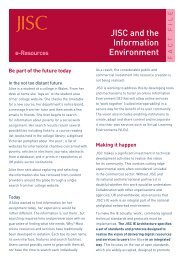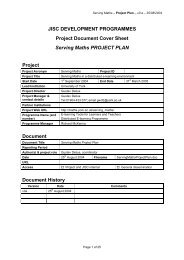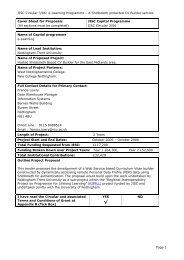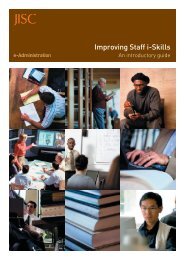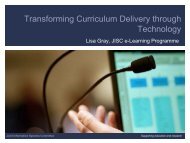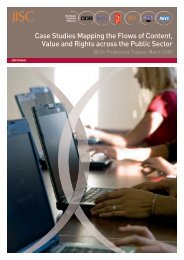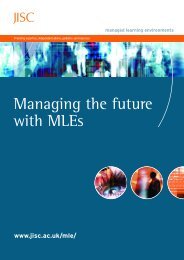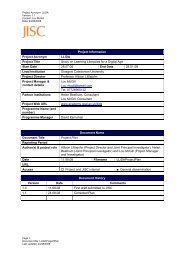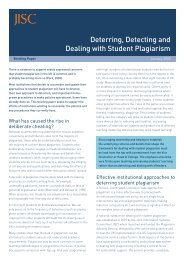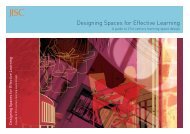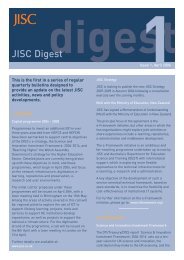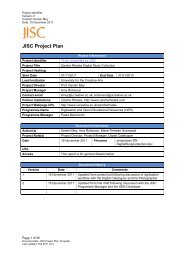Assessment of file format testing tools - Jisc
Assessment of file format testing tools - Jisc
Assessment of file format testing tools - Jisc
Create successful ePaper yourself
Turn your PDF publications into a flip-book with our unique Google optimized e-Paper software.
Digital Asset <strong>Assessment</strong> Tool – File Format Testing Tools -Version 1.2 – 2006-12-13<br />
4. AIHT / Empirical Walker summary assessment<br />
4.1 Overview<br />
This is a project based at Stanford University in the USA, which the DAAT project learned<br />
about in Washington from Keith Johnson (in May 2006). An article about the project was<br />
published in D-Lib magazine December 2005 6 . The AIHT (Archive Ingest and Handling Test)<br />
is a Library <strong>of</strong> Congress project to create a small real-world digital archive, <strong>of</strong> which Stanford<br />
are one <strong>of</strong> the four participating institutions.<br />
Unlike DROID and JHOVE, this is not a separate tool as much as an entire methodology, a<br />
process for automated assessment <strong>of</strong> preservation risk. However, the Stanford team have<br />
evolved an automation tool which is an integral part <strong>of</strong> their process; they call this tool<br />
‘Empirical Walker’.<br />
The D-Lib article describes a fundamentally different approach to that <strong>of</strong> the National<br />
Preservation Office’s L-PAS model. Stanford based their model on workflow, not on static<br />
collections; they devised s<strong>of</strong>tware to analyse large numbers <strong>of</strong> <strong>file</strong> <strong>format</strong>s in a hard drive; and<br />
created an XML output from the process.<br />
They keep stressing in their report that, for best results, analysis <strong>of</strong> <strong>file</strong>s and metadata<br />
extraction had to be automated, not performed manually. They recognised that automation<br />
would allow them to scale the methodology, provide trustworthy data on the collections,<br />
maintain control <strong>of</strong> workflow, and treat a collection as a manageable set <strong>of</strong> objects.<br />
The results <strong>of</strong> the analysis take place within a tight framework <strong>of</strong> pre-determined in<strong>format</strong>ion,<br />
concerning the preservation policy <strong>of</strong> the organisation, and in<strong>format</strong>ion about sets <strong>of</strong> preferred<br />
preservation <strong>format</strong>s. 7 It was tied in an earlier questionnaire form (built by their Technology<br />
<strong>Assessment</strong> Group) which enabled them to evaluate digital objects by classes.<br />
Stanford also made provision for assessing thing like context, meaning, value and importance<br />
<strong>of</strong> assets – through questions directed at the content owner.<br />
So their approach was to build two parallel devices:<br />
1) A mechanism to raise questions about the nature <strong>of</strong> the objects, based on classes<br />
2) A tool to gather in<strong>format</strong>ion about an individual object (or related objects)<br />
At time <strong>of</strong> writing, ULCC do not have a copy <strong>of</strong> the Empirical Walker s<strong>of</strong>tware to assess, so<br />
this assessment is based entirely on the report given by Stanford staff in their D-Lib article.<br />
4.2 Range <strong>of</strong> test sample<br />
Not known for certain, but Table 1 in the D-Lib article indicates a wide range <strong>of</strong> <strong>format</strong>s: Text<br />
<strong>format</strong>s, including ASCII and UTF-8; Image / Graphic <strong>format</strong>s, including JPEG, GIF, TIFF,<br />
BMP, PNG, and Photoshop; MS Office documents, including .DOC, .XLS and .PPT; Audio<br />
<strong>format</strong>s (including WAVE, MP3, and AIFF); Video <strong>format</strong>s, including MPEG, Real, QuickTime<br />
and Windows Media); and possibly more.<br />
4.3 Some aspects <strong>of</strong> Empirical Walker tool<br />
It’s an automated workflow; it surveys a collection automatically.<br />
It describes and assesses a collection <strong>of</strong> digital objects (and judging by published results, can<br />
process large numbers <strong>of</strong> them very quickly).<br />
It drives external assessment <strong>tools</strong> (including JHOVE, which was used as part the Stanford<br />
project).<br />
6 ‘The AIHT at Stanford University’, by Richard Anderson et al. D-Lib Magazine December 2005, Volume 11, Number<br />
12. ISSN 1082-9873.<br />
7 The UK Data Archive also has a table <strong>of</strong> preferred ‘Principal Ingest Formats’ and ‘Preservation Formats’ for the<br />
types <strong>of</strong> data they handle. (See <strong>Assessment</strong> <strong>of</strong> UKDA and TNA compliance with OAIS and METS standards, p 89).<br />
9




